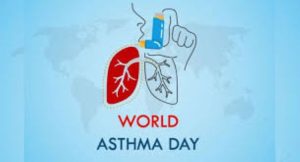Breathless nation: Tackling the growing burden of asthma
Dr Srinivas Jakka
Asthma, a chronic respiratory condition marked by airway inflammation and constriction, is increasingly prevalent in India. As of 2024, approximately 34.3 million Indians are affected, representing about 13 per cent of the global asthma burden. Alarmingly, India accounts for 46 per cent of global asthma-related deaths, highlighting significant challenges in disease management and awareness. Asthma can affect people of all ages, but it most commonly begins in childhood. Here’s how it typically breaks down:
Children (0–14 years): Asthma is particularly prevalent in this age group. According to the Global Asthma Report 2022, nearly 10 per cent of Indian children suffer from asthma symptoms. In urban areas like Hyderabad, paediatricians report that 20–25 per cent of their young patients present with asthma or asthma-like symptoms, often triggered by pollution, dust mites, or respiratory infections.
Adolescents (15–19 years): Asthma often continues from childhood into adolescence, with hormonal changes, stress, and continued exposure to environmental triggers exacerbating symptoms.
Although Asthma can affect anyone, children under 14 years are the most commonly affected group, followed by a rising incidence in adult women due to environmental and lifestyle factors.
In Telangana, particularly Hyderabad, medical professionals have observed a notable rise in asthma cases, especially during winter months. Up to 80 per cent of allergic reactions during this season are attributed to indoor allergens like house dust mites and moulds. Clinics report that 40–50 per cent of patients present with respiratory symptoms, including acute asthma exacerbations.
Air pollution remains a significant trigger for asthma. In January 2024, severe air quality in Delhi led to a surge in asthma medication sales. This indicates a direct correlation between pollution levels and asthma flare-ups.
Despite the availability of effective treatments; under diagnosis and inadequate use of inhaled corticosteroids (ICS) persist. Less than 10 per cent of diagnosed patients in India use ICS regularly, often due to misconceptions and lack of awareness.
Addressing asthma’s growing burden necessitates a multifaceted approach that goes beyond symptomatic relief to long-term disease control. While asthma does not have a permanent cure, it can be effectively managed through a combination of medical treatment, lifestyle adjustments, and environmental interventions. The cornerstone of asthma management is the regular use of inhaled corticosteroids (ICS), which reduce inflammation in the airways and prevent the onset of severe attacks. Despite their proven efficacy, usage remains dismally low in India—with fewer than 10% of diagnosed patients adhering to ICS-based therapy. Increasing awareness around the safety and effectiveness of inhalers is critical to bridging this gap.
For patients experiencing frequent symptoms or nighttime disturbances, long-acting bronchodilators (LABAs) are often prescribed in combination with ICS. In acute episodes, short-acting beta-agonists (SABAs) like salbutamol are used for immediate relief. Newer biologic therapies, such as omalizumab and mepolizumab, have shown promising results in patients with severe asthma that doesn’t respond to standard treatment, though access and affordability remain challenges in India.
Non-pharmacological interventions play a vital role too. Identifying and avoiding specific triggers—such as pollen, pet dander, household dust, tobacco smoke, and air pollution—is essential. In cities like Hyderabad, where environmental allergens and pollutants are rampant, using air purifiers, maintaining clean indoor environments, and improving ventilation can significantly reduce symptom frequency. Breathing exercises and pulmonary rehabilitation programs have also shown to improve lung function and overall quality of life for asthma patients.
Equally important is early diagnosis—particularly in children, who often go undiagnosed due to misinterpretation of wheezing and cough as recurrent infections. Regular screening in schools, public health campaigns, and training for primary care physicians can aid in timely intervention.
Ultimately, a collaborative approach is vital. Healthcare providers must ensure patient education and personalized treatment plans; policymakers should improve access to essential asthma medications; and communities must support awareness campaigns to reduce stigma and encourage early care-seeking. With sustained and integrated action, asthma can be controlled effectively, preventing hospitalizations, improving daily functioning, and enabling individuals to lead full and active lives.
Dr Srinivas Jakka is Consultant in Paediatrics, Pulmonology & Allergy,
Ankura Hospital for Women and Children


